

2015 FEB 7
(DEC 22) SAN DIEGO, Calif. - A new analysis of a Martian rock that meteorite hunters plucked from an Antarctic ice field 30 years ago this month reveals a record of the planet's climate billions of years ago, back when water likely washed across its surface and any life that ever formed there might have emerged. More

Global atmospheric carbon dioxide concentrations from Oct. 1 through Nov. 11, as recorded by NASA's Orbiting Carbon Observatory-2. Carbon dioxide concentrations are highest above northern Australia, southern Africa and eastern Brazil. Preliminary analysis of the African data shows the high levels there are largely driven by the burning of savannas and forests. Elevated carbon dioxide can also be seen above industrialized Northern Hemisphere regions in China, Europe and North America. OCO-2 was launched from Vandenberg AFB aboard a Delta II rocket in July 2014. Image credit: NASA/JPL-Caltech
(DEC 15) SACRAMENTO, Calif. - Aerojet Rocketdyne, a GenCorp (NYSE: GY) company, has successfully completed a hot-fire test of its MPS-120™ CubeSat High-Impulse Adaptable Modular Propulsion System™ (CHAMPS™). More
(DEC 12) VANDENBERG AIR FORCE BASE, Calif. - Team Vandenberg successfully launched the United Launch Alliance Atlas V rocket carrying a National Reconnaissance Office payload from Space Launch Complex-3 here Friday, Dec. 12, at 7:19 p.m. PDT. More
(DEC 11) Vandenberg Air Force Base, Calif. - The launch of a United Launch Alliance Atlas V rocket carrying the NROL-35 payload for the National Reconnaissance Office was scrubbed today due to predicted violations of multiple weather criteria.
The launch is rescheduled for Friday, Dec. 12 from Space Launch Complex-3 at Vandenberg Air Force Base, Cal. The launch time is 7:13 p.m. PST. The forecast for Dec. 12 shows a 40 percent chance of favorable weather conditions for the launch tomorrow.
United Launch Alliance
(DEC 8) VANDENBERG AIR FORCE BASE, Calif. - Team Vandenberg is scheduled to launch a United Launch Alliance Atlas V rocket carrying a National Reconnaissance Office payload from Space Launch Complex-3 here Thursday, Dec. 11, with a launch window opening at 7:17 p.m. PDT.
Col. Keith Balts, 30th Space Wing commander will be the launch decision authority.
"Our team and mission partners have put a lot of hard work into preparing for this important mission for our Nation," said Balts. "We are looking forward to a safe and successful launch to close out an amazing year."
The 4th Space Launch Squadron is in charge of mission assurance and safety for this launch operation.
"A launch like this takes teamwork and dedication," said Lt. Col. James Bodnar, 4th SLS commander. "Our mission assurance technicians and engineers have worked hand-in-hand with United Launch Alliance going over critical procedures and tasks to ensure this launch is a safe and successful one."
Vandenberg AFB

NASA's Orion spacecraft is pulled safely into the well deck of the U.S. Navy's USS Anchorage on December 5 following splashdown some 630 miles south of San Diego, Calif. The splashdown marked the end of a successful two-orbit, unmanned test flight. The spacecraft will be off loaded at Naval Base San Diego on Monday. The Orion spacecraft is being developed to take humans farther into space than they have ever gone before. Photo credit: NASA
(DEC 3) UC Santa Cruz has been awarded $350,000 in combined grant and donor funds for a major upgrade to the Kast Spectrograph at Lick Observatory. More
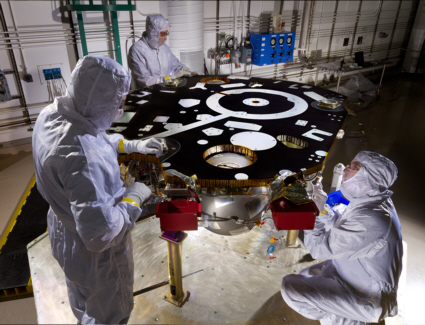
Technicians in a Lockheed Martin clean room near Denver prepare NASA's InSight Mars lander for propulsion proof and leak testing. The InSight mission (for Interior Exploration using Seismic Investigations, Geodesy and Heat Transport) is scheduled to launch from Vandenberg AFB, Calif. in March 2016 and land on Mars six months later. It will investigate processes that formed and shaped Mars and will help scientists better understand the evolution of our inner solar system's rocky planets, including Earth. Image credit: NASA/JPL-Caltech/Lockheed Martin
(NOV 19) SANTA BARBARA, Calif. - This month's public viewing of the stars will feature astronomical glimpses of a heart, owl and a Christmas tree on Friday, Nov. 21, beginning after 6:30 p.m. and lasting for several hours at the Westmont Observatory. The free event is held every third Friday of the month in conjunction with the Santa Barbara Astronomical Unit. In case of inclement or overcast weather, please call the Telescope Viewing Hotline at (805) 565-6272 and check the Westmont website to see if the viewing has been canceled.
Thomas Whittemore, Westmont physics instructor, says he hopes to aim Westmont's 8-inch refractor telescope at the northern part of the sky where there'll be a number of open clusters with interesting patterns of stars.
Westmont College
(NOV 14) LAS CRUCES, NM -The NMSU Department of Astronomy and Southern New Mexico Natural History Foundation will host a Sky Safari event from 7 to 9 p.m. Saturday, Nov. 15, at the NMSU Campus Observatory. Participants will be able to observe the Andromeda Galaxy as well as several open and globular star clusters.
New Mexico State University
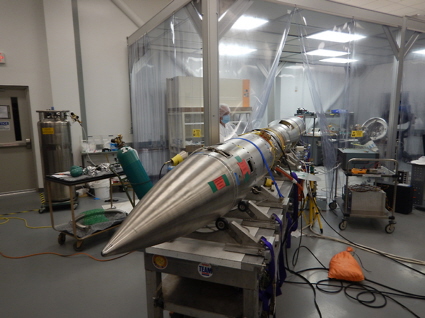
A sounding rocket undergoes testing prior to its November 6 launch on a brief trip into space from White Sands Missile Range, New Mexico. The mission, known as RAISE (Rapid Acquisition Imaging Spectrograph Experiment), was flown to capture five images of the sun per second and focus on the split-second changes that occur near active regions on the sun. Image Credit: NASA/RAISE
(NOV 6) SUNNYVALE, Calif. - The U.S. Navy and Lockheed Martin [NYSE: LMT] have delivered the third Mobile User Objective System (MUOS) spacecraft to Cape Canaveral Air Force Station, Florida, where it will be prepared for a January 2015 liftoff aboard a United Launch Alliance Atlas V rocket.
"The delivery of MUOS-3 is an important step toward enabling our warfighters to be able to pick up the phone to seamlessly call or transfer data anywhere around the world," said Iris Bombelyn, vice president of Narrowband Communications at Lockheed Martin. "With the launch of the third satellite in the constellation, to be followed later in 2015 by the fourth, MUOS will be in place to provide pole-to-pole and global, secure communications for the warfighter."
MUOS-3's safe transport to Cape Canaveral Air Force Station began from Lockheed Martin's Sunnyvale, California, facility to nearby Moffett Federal Airfield. There, the 60th Air Mobility Wing of Travis Air Force Base loaded the satellite aboard a C-5 aircraft for final shipment on Nov. 5.
Lockheed Martin Space Systems, Sunnyvale, California, is the MUOS prime contractor and system integrator. The Navy's Program Executive Office for Space Systems and its Communications Satellite Program Office, San Diego, California, are responsible for the MUOS program.
Lockheed Martin Space Systems
(OCT 28) ALBUQUERQUE, N.M. - The first flight and drop tests for the latest variant of the W88 nuclear warhead are providing data for Sandia National Laboratories to validate designs, improve computer modeling and update component specifications. More
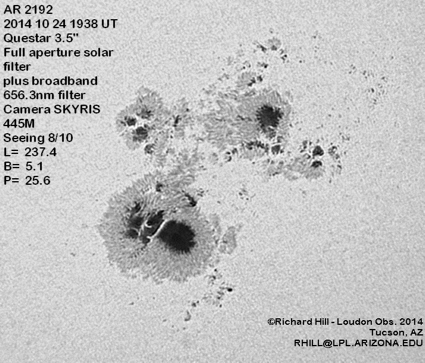
Solar activity was high this week, thanks in large part to a hot spot on the Sun known as Active Region 2192. AR2192 unleashed two X-class solar flares and affected high frequency (shortwave) radio conditions on Earth, some 93 million miles away. Rik Hill imaged AR 2192 from Tucson Ariz. on October 24 using a 3.5-inch Questar telescope and a SKYRIS camera. Image copyright 2014, Rik Hill. Used with permission
(OCT 22) NASA has awarded a sole source contract modification to Northrop Grumman Electronic Systems, of Azusa, California, for the Advanced Technology Microwave Sounder (ATMS) Instrument for flight on the Joint Polar Satellite System-2 (JPSS-2) mission.
This is a cost-plus-award-fee modification in the amount of $121 million.
The JPSS-2 mission is funded by the National Oceanic and Atmospheric Administration (NOAA) to provide global environmental data in low-Earth polar orbit in support of NOAA's mission.
Under this contract, Northrop Grumman Electronic Systems will manufacture, test and deliver the ATMS instrument, support instrument integration on the JPSS-2 spacecraft and provide launch and post-launch support.
ATMS is a passive microwave instrument that works in conjunction with the Cross-track Infrared Sounder (CrIS) to produce global atmospheric temperature and moisture profiles. ATMS provides high spatial resolution microwave data to support temperature and humidity sounding data in all weather conditions. NOAA forecasters will use this data in computer models to improve global and regional predictions of weather patterns, storm tracks and precipitation.
NASA
(OCT 17) VANDENBERG AIR FORCE BASE, Calif. - The X-37B Orbital Test Vehicle mission 3 (OTV-3), the Air Force's unmanned, reusable space plane, landed at Vandenberg Air Force Base at 9:24 a.m. Oct. 17. More
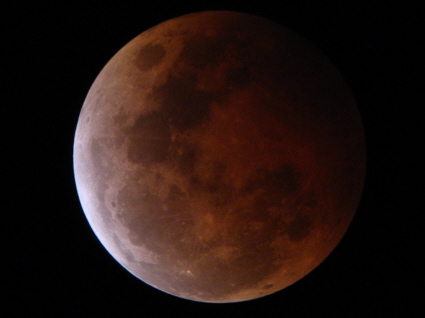
The full Moon takes on a dull copper-red color during a total lunar eclipse on October 9. The pre-dawn event was visible to the unaided eye from the U.S. West Coast and beyond. Robert Lunsford recorded this image of the Moon during totality from Chula Vista, California at 04:15 PDT using a 9.25-inch Schmidt-Cassegrain telescope, Canon Power Shot S2 IS camera, and an exposure time of 1.3 seconds. Image copyright 2014, Robert Lunsford. Used with permission.
(OCT 10) For the first time in the 27-year launch history in Fort Sumner, N.M., New Mexico State University's Physical Science Laboratory's Columbia Scientific Balloon Facility team launched three balloon experiments on three consecutive days for NASA's Scientific Balloon Program. More
(SEP 23) VANDENBERG AIR FORCE BASE, Calif. - An unarmed Minuteman III intercontinental ballistic missile was launched during an operational test at 7:45 a.m. here Tuesday.
Col. Keith Balts, 30th Space Wing commander, was the launch decision authority.
"An outstanding display of teamwork ensured 100-percent mission success for the first Minuteman launch of the year here at Vandenberg," said Col. Balts. "We constantly focus on flawless execution of our launch, range and expeditionary missions. I am extremely proud of the collaboration between the 30th SW and the 576th FLTS."
Vandenberg AFB
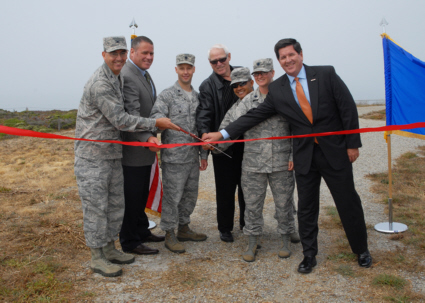
U.S. Air Force and InDyne dignitaries participate in a ribbon cutting ceremony September 10 at Pillar Point Air Force Station, Calif. Located four hours north of Vandenberg AFB, Pillar Point supports launches from Vandenberg by transmitting commands to destroy vehicles in the event of an anomaly and by receiving telemetry transmitted from vehicles during flight. The ceremony marked the modernization of Pillar Point AFS through replacement of the Command Transmitter 4, which was in service since the 1960's, and a major modification involving the facility's telemetry system. U.S. Air Force photo by Senior Airman Armando Aparicio Jr.
(SEP 16) The newest Defense Meteorological Satellite Program (DMSP) satellite, built by Lockheed Martin [NYSE: LMT], was accepted for operations by U.S. Strategic Command (USSTRATCOM) on August 19. More
(SEP 10) EL SEGUNDO, Calif. - Boeing [NYSE: BA] has received its first commercial order for the 502 Phoenix small satellite from HySpecIQ of Washington, D.C. More

In the 14 years since its launch from Vandenberg AFB, Calif., NASA's Terra spacecraft has images numerous atmospheric phenomena. On August 26 at 12:05 PDT (19:05 UTC) Terra satellite imaged a weakening Hurricane Marie as it swirled off the coast of Mexico. At the time this image was captured, Marie measured over 400 miles in diameter. Image Credit: Jeff Schmaltz, MODIS Land Rapid Response Team, NASA GSFC
(SEP 2) MOUNTAIN VIEW, Calif. - For the first time since 1997, NASA's Ames Research Center in Moffett Field, California, will open its gates and share its world-class space and aeronautics research campus with surrounding communities on Oct. 18, 2014. Starting today, free general admission tickets are available for the event.
The event will feature exhibits highlighting Ames' space missions, a two-mile, self-guided walking tour past facilities including huge wind tunnels and Ames' simulated Martian landscape, opportunities to visit with Ames engineers and scientists, and family-friendly talks with Ames researchers. Participants can learn more about Ames' major contributions to the International Space Station, the Curiosity Mars rover, the Lunar Atmosphere and Dust Environment Explorer (LADEE) orbiter, the Stratospheric Observatory for Infrared Astronomy (SOFIA) research aircraft and the planet-hunting Kepler mission, and see demonstrations of technologies invented at Ames in the center's 75-year history.
Tickets with reserved entry times are required. This is a pedestrian-only event; no on-site visitor parking will be permitted. Public transportation is highly encouraged. Buses will shuttle visitors from local public transit stations to Ames. Other transportation options will be posted on the event website.
For more information and to register for the Open House, visit: http://www.nasa.gov/ames/openhouse2014/
NASA Ames Research Center
(AUG 29) The launch of NASA's SMAP spacecraft from Vandenberg AFB has been delayed indefinitely. The soil moisture-measuring mission was slated to lift-off aboard a Delta II rocket shortly after sunrise on November 5.
A Jet Propulsion Laboratory official told Space Archive that the launch was delayed to allow for additional testing and evaluation that includes the SMAP antenna Reflector Boom Assembly (RBA). The purpose of the additional testing and evaluation is to ensure that the spacecraft will function as intended after launch.
The official also said that the launch date is currently listed as indefinite. However, NASA will attempt to identify the earliest possible launch opportunity between mid-December and late February. NASA should announce a new date in late September.
Brian Webb
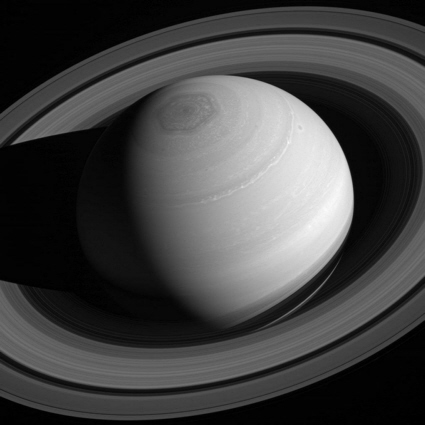
Saturn and its rings are suspended against the blackness of space in this Cassini spacecraft image released on August 18. The spacecraft recorded this view from a distance of approximately 2 million miles (3 million kilometers) from Saturn. The Jet Propulsion Laboratory manages the Cassini mission for NASA's Science Mission Directorate in Washington. The Cassini orbiter and its two onboard cameras were designed, developed and assembled at JPL. Credit: NASA/JPL-Caltech/Space Science Institute
(AUG 20) SACRAMENTO, Calif., - Aerojet Rocketdyne, a GenCorp (NYSE: GY) company, has received the Outstanding Achievement Award from the Electric Propulsion Technical Committee at the American Institute of Aeronautics & Astronautics for its contribution to the Advanced Extremely High Frequency-1 (AEHF-1) Rescue Team. The team, which included two other aerospace companies and the U.S. Air Force, helped save the AEHF-1 military communications satellite and place it into proper orbit after the spacecraft's main bipropellant engine failed to ignite.
The AEHF-1 satellite was successfully launched aboard a United Launch Alliance Atlas V booster in August 2010, and was expected to reach geosynchronous orbit within 100 days. But the bi-propellant propulsion system on the satellite's main engine failed, stranding the AEHF-1 in the wrong orbit and placing it at risk of being a total loss. The AEHF-1 Rescue Team was assembled and devised a plan to use the spacecraft's smaller hydrazine thrusters to lift the orbit above the atmosphere and then use the electric Hall thruster system to complete the orbit-raising mission-with whisper-like impulses-until it reached its desired orbit 14 months later.
Aerojet Rocketdyne
(AUG 13) VANDENBERG AIR FORCE BASE, Calif. - Team Vandenberg supported the successful launch of a commercial satellite on a United Launch Alliance Atlas V rocket from Space Launch Complex-3 here Wednesday, Aug. 13, at 11:30 a.m. PDT.
Col. Marc Del Rosario, 30th Operations Group commander, was the launch decision authority.
"The 30th Space Wing is proud of supporting the successful launch of a high-resolution commercial earth imaging satellite with the United Launch Alliance team," said Del Rosario. "Today's launch is a testament to the professionalism and commitment to mission assurance, public safety, and mission success on the Western Range."
The Atlas V rocket carried the DigitalGlobe WorldView-3 satellite.
This satellite will further enhance the DigitalGlobe collection capacity for more rapid and reliable collection and expand its imagery product offerings.
Vandenberg AFB
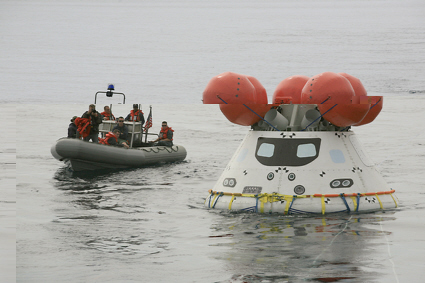
U.S. Navy personnel use a rigid hull inflatable boat to approach a boilerplate Orion spacecraft during a recovery test in the Pacific Ocean off of San Diego, Calif. on August 2. Orion is America's next generation spacecraft that will take astronauts to destinations never explored by humans. Image Credit: NASA/Kim Shiflett
(AUG 7) VANDENBERG AIR FORCE BASE, Calif. - Team Vandenberg is scheduled to launch the WorldView-3 satellite on an Atlas V rocket from Space Launch Complex-3 here Wednesday, Aug. 13, with a launch window opening at 11:29 a.m. PDT.
The WorldView-3 satellite was built by DigitalGlobe and United Launch Alliance builds and flies the rocket. The 30th Space Wing at Vandenberg Air Force Base is responsible for range safety and launch operations.
Col. Marc Del Rosario, 30th Operations Group commander, will be the launch decision authority.
"The entire 30th Space Wing team of military, government civilians, and contractors are all honored to launch the first Atlas V commercial mission from Vandenberg AFB. The team's planning and behind the scenes hard-work with United Launch Alliance, Lockheed Martin, and the Federal Aviation Administration are all integral to provide safe launch operations on the Western Range," said Del Rosario, this mission's launch decision authority.
WorldView-3 is the first multi-payload, super-spectral, high-resolution commercial satellite. The satellite will provide 31 cm panchromatic resolution, 1.24 m multispectral resolution, and 3.7 m short-wave infrared resolution with an average revisit time of less than 1 day. This will further enhance the DigitalGlobe collection capacity for more rapid and reliable collection and expand its imagery product offerings.
Vandenberg AFB
(JUL 30) New research shows that more than four billion years ago the surface of Earth was heavily reprocessed - or melted, mixed, and buried - as a result of giant asteroid impacts. More
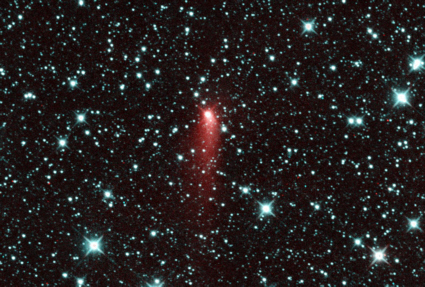
Once thought to be an asteroid, Comet C/2013 UQ4 (Catalina) glows brightly in this recently released infrared image from NASA's Wide-field Infrared Survey Explorer (WISE) spacecraft. WISE imaged the comet just one day after the object's closest approach to the sun. WISE was launched from Vandenberg AFB, Calif. in late 2009.
(JUL 23) The following is a statement from Hawthorne, Calif.-based SpaceX:
"Following last week's successful launch of six ORBCOMM satellites, the Falcon 9 rocket's first stage reentered Earth's atmosphere and soft landed in the Atlantic Ocean. This test confirms that the Falcon 9 booster is able to consistently reenter from space at hypersonic velocity, restart main engines twice, deploy landing legs and touch down at near zero velocity.
After landing, the vehicle tipped sideways as planned to its final water safing state in a nearly horizontal position. The water impact caused loss of hull integrity, but we received all the necessary data to achieve a successful landing on a future flight. Going forward, we are taking steps to minimize the build up of ice and spots on the camera housing in order to gather improved video on future launches.
At this point, we are highly confident of being able to land successfully on a floating launch pad or back at the launch site and refly the rocket with no required refurbishment. However, our next couple launches are for very high velocity geostationary satellite missions, which don't allow enough residual propellant for landing. In the longer term, missions like that will fly on Falcon Heavy, but until then Falcon 9 will need to fly in expendable mode.
We will attempt our next water landing on flight 13 of Falcon 9, but with a low probability of success. Flights 14 and 15 will attempt to land on a solid surface with an improved probability of success."
(JUL 15) HUNTINGTON BEACH, Calif., July 15, 2014 - Boeing [NYSE: BA] plans to design a reusable launch vehicle for the Defense Advanced Research Projects Agency (DARPA) in support of the U.S. government's efforts to reduce satellite launch costs. DARPA's XS-1 Experimental Spaceplane is conceived as a reusable, unmanned booster with costs, operation and reliability similar to modern aircraft.
Under the $4 million preliminary design contract, Boeing plans to work on a reusable first stage launch vehicle capable of carrying and deploying an upper stage to launch small satellite payloads of 3,000 to 5,000 pounds (1,361 kg to 2,268 kg) into low-Earth orbit.
"Our design would allow the autonomous booster to carry the second stage and payload to high altitude and deploy them into space. The booster would then return to Earth, where it could be quickly prepared for the next flight by applying operation and maintenance principles similar to modern aircraft." said Will Hampton, Boeing XS-1 program manager.
DARPA plans to hold a Phase II competition next year for the follow-on production order to build the vehicle and conduct demonstration flights.
Boeing

Typhoon Neoguri swirls in the East China Sea in this night image recorded by the American Suomi NPP satellite at 2:07 a.m. Japan Standard Time on July 9. The storm was imaged by a special "day-night band" that detects light in a range of wavelengths from green to near-infrared and uses light intensification to detect dim signals. The instrument can sense light as much as 100,000 times fainter than conventional visible-light sensors, making it very sensitive to moonlight and city lights. In this case, the cloud tops were lit by the nearly full Moon. Suomi was launched from California's Vandenberg AFB in October 2011. Image courtesy NASA
(JUL 9) Join dozens of astronomy product manufacturers, organizations, and clubs at Oceanside Photo and Telescope's annual Southern California Astronomy Expo on Saturday, July 12th.
The free event will be held from 10 a.m. - 6 p.m. at OPT's showroom at 918 Mission Ave., Oceanside, Calif.
For more information, go to:
Brian Webb
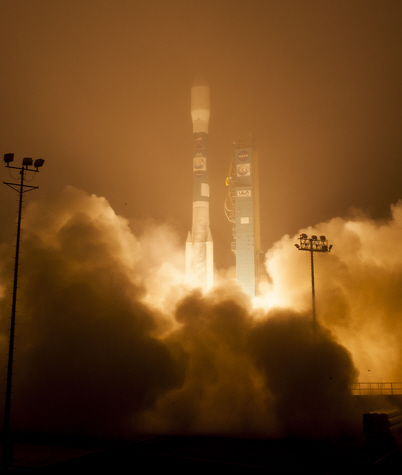
A United Launch Alliance Delta II rocket launches with the Orbiting Carbon Observatory-2 (OCO-2) satellite onboard from Space Launch Complex 2 at Vandenberg Air Force Base, Calif. on Wednesday, July 2. OCO-2 will measure the global distribution of carbon dioxide. Image Credit: NASA/Bill Ingalls
(JUL 2) VANDENBERG AIR FORCE BASE, Calif. - A NASA satellite on a United Launch Alliance rocket was launched from Space Launch Complex-2 here Wednesday, July 2, at 2:56 a.m. PDT.
Col. Keith Balts, 30th Space Wing commander, was the launch decision authority.
The Delta II rocket carried NASA's Orbiting Carbon Observatory-2; the second of NASA's five Earth science missions to launch in 2014.
OCO-2 is NASA's first mission dedicated to studying atmospheric carbon dioxide, the leading human-produced greenhouse gas driving changes in Earth's climate. OCO-2 will provide a new tool for understanding the human and natural sources of carbon dioxide emissions and the natural "sinks" that absorb carbon dioxide and help control its buildup. The observatory will study their changes over time.
Vandenberg AFB
(JUN 27) Next Tuesday's early morning launch of a Delta II rocket from Vandenberg AFB remains on schedule. More
(JUN 22) The Missile Defense Agency, U.S. Air Force 30th Space Wing, the Joint Functional Component Command, Integrated Missile Defense, U.S. Northern Command and the U.S. Navy completed an integrated exercise of the Ground-based Midcourse Defense (GMD) element of the nation's Ballistic Missile Defense System (BMDS). More
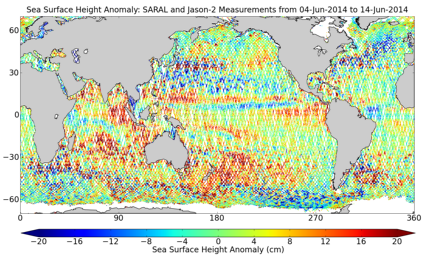
The height of the surface of the world's oceans is revealed in this recent image created from data from India's SARAL and NASA's Jason-2 satellites. The highest areas are shown in red and the lowest areas are in blue. Jason-2 was launched from Vandenberg AFB in 2008.
(JUN 13) The following is a NASA update regarding Orbiting Carbon Observatory-2 pre-launch preparations at Vandenberg AFB:
"Engineers and technicians performed additional mechanical preparations so OCO-2 would be ready for its move to Space Launch Complex 2 at Vandenberg Air Force Base in California. Currently inside the Astrotech payload processing facility at Vandenberg, the OCO-2 spacecraft will be taken to the launch pad in the early morning on Saturday and hoisted to the top of the United Launch Alliance Delta II rocket already assembled there. The carbon observatory will be encapsulated in its payload fairing June 20 for launch July 1 at 2:56:44 a.m. PDT."
(JUN 4) LOS ANGELES AIR FORCE BASE, El Segundo, Calif. --- The Air Force awarded a $914,699,474 contract to Lockheed Martin on June 2, 2014 to develop a system that will track objects in Earth's orbit with far greater confidence and fidelity.
The contract brings the program to final system development with the delivery of Space Fence Increment 1, or site 1, radar and a Space Fence operations center. The projected initial operational capability is fiscal year 2019. The contract also includes an option for procuring a second radar site.
The system will track space objects in Earth's orbit. According to program officials, it will improve space situational awareness by detecting and tracking objects such as commercial and military satellites and debris from break-up events. Coverage will extend down to just above the horizon to handle low-inclination orbits.
Space Fence is designed to provide assured coverage at low Earth orbit for objects as small as 10 centimeters. The system will also support cued searches and uncued surveillance at medium Earth orbit and above.
Los Angeles AFB
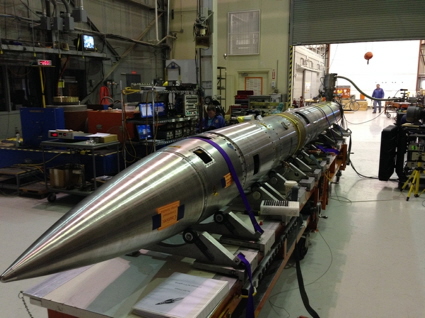
The Colorado High-resolution Echelle Stellar Spectrograph, or CHESS, sounding rocket gets ready for a brief trip into space to observe an area of star formation. The Black Brant IX suborbital sounding rocket was launched from White Sands Missile Range in New Mexico early on the morning of May 24. Kevin France at the University of Colorado at Boulder reports that good data was received and the mission was a success. Image Credit: NASA/WSMR
(MAY 27) HAWTHORNE, Calif. - Space Exploration Technologies Corp. (SpaceX) announced today that it has completed qualification testing for the SuperDraco thruster, an engine that will power the Dragon spacecraft's launch escape system and enable the vehicle to land propulsively on Earth or another planet with pinpoint accuracy. More
(MAY 19) NASA and its international partners now have the go-ahead to begin construction on a new Mars lander after it completed a successful Mission Critical Design Review on Friday.
NASA's Interior Exploration Using Seismic Investigations, Geodesy and Heat Transport (InSight) mission will pierce beneath the Martian surface to study its interior. The mission will investigate how Earth-like planets formed and developed their layered inner structure of core, mantle and crust, and will collect information about those interior zones using instruments never before used on Mars.
InSight will launch from Vandenberg Air Force Base, on the central California coast near Lompoc, in March 2016. This will be the first interplanetary mission ever to launch from California. The mission will help inform the agency's goal of sending a human mission to Mars in the 2030's.
NASA
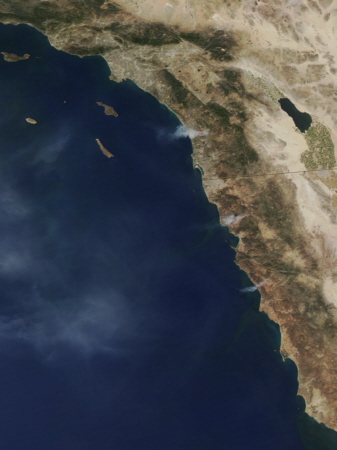
The Moderate Resolution Imaging Spectroradiometer (MODIS) on NASA's Aqua satellite detected fire activity north of San Diego, California, on 2014 May 15. MODIS also observed fires burning in the Baja California region of Mexico. Red outlines indicate hot spots where the sensor detected unusually warm surface temperatures associated with fires. Winds blew thick plumes of smoke west over the Pacific Ocean. As of May 16, brush fires in California had burned thousands of acres, destroyed several homes, killed at least one person, and forced thousands of people to evacuate. Aqua was launched from Vandenberg AFB in 2002. Image and caption courtesy NASA Goddard Spaceflight Center
(MAY 13) SANTA BARBARA, Calif. - Westmont's powerful Keck Telescope will zoom in on the planet Mars during a free, public viewing Friday, May 16, beginning at 7:30 p.m. The best viewing generally occurs later in the evening. In case of inclement or overcast weather, please call the Telescope Viewing Hotline at (805) 565-6272 and check the Westmont website to see if the viewing has been canceled.
As Jupiter continues to get lower in the western sky, Thomas Whittemore, Westmont physics instructor, says the target this month will be Mars. "Last month, because of the steady skies, we were able to see, at high power, one of Mars' polar caps," he says.
Westmont College
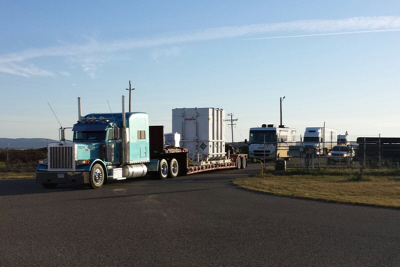
(APR 30) A NASA spacecraft designed to make precise measurements of carbon dioxide in Earth's atmosphere is at Vandenberg Air Force Base, Calif., to begin final preparations for launch. More
(APR 25) WISE, an infrared satellite launched from Vandenberg AFB in 2009, and another NASA spacecraft have discovered a cold, dim, star-like object a few light years from our sun. More
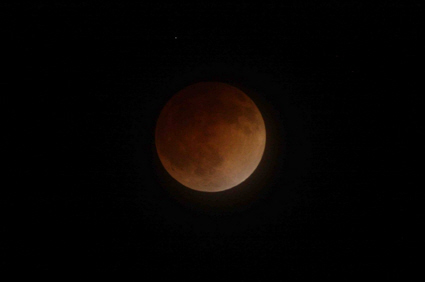
The United States was in a prime position to view a total lunar eclipse the night of April 14-15. Depending on local weather conditions, the public got a spectacular view as the moon's appearance changed from bright orange to blood red to dark brown and perhaps gray as the orb entered the Earth's shadow. Brian Day recorded the event in this image taken from San Jose, Calif. Image courtesy NASA Ames Research Center/Brian Day
(APR 17) The New Mexico Exoplanet Spectroscopic Survey Instrument (NESSI) will soon get its first "taste" of exoplanets, helping astronomers decipher their chemical composition. More
(APR 13) If the weather cooperates, observers in the Southwest and beyond will be well situated to see a total lunar eclipse on the night of April 14-15.
As seen from California, the Moon will be well above the horizon for the entire event.
The circumstances of the eclipse are as follows:
| Event | PDT |
|---|---|
| Partial eclipse begins | 10:58 p.m. |
| Totality begins | 12:06 a.m. |
| Maximum eclipse | 12:45 a.m. |
| Totality ends | 1:22 a.m. |
| Partial eclipse ends | 2:33 a.m. |
All you will need to see the event are the unaided eye and perhaps a reclining chair. For the best view, use tripod-mounted binoculars or a small telescope at low magnification.
Throughout the night, the Moon will be accompanied by Mars. The orange-red planet will be shining brightly about 9 degrees to the Moon's upper right at maximum eclipse. Although the two objects will appear to be relatively close, Mars will actually be some 57 million miles behind the Moon.
Brian Webb
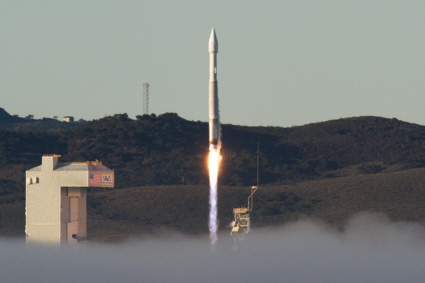
An Atlas V rocket carrying the DMSP F-19 military weather satellite lifts off from south Vandenberg on April 3. Image copyright 2014, James Eberling. Used with permission
(APR 3) VANDENBERG AIR FORCE BASE, Calif. - Team Vandenberg successfully launched the 19th U.S. Air Force Defense Meteorological Satellite Program payload on an Atlas V rocket from Space Launch Complex-3 here Thursday, April 3, at 7:46 am PDT. More
(MAR 28) An Atlas V rocket carrying the DMSP F-19 military weather satellite is scheduled for launch from Vandenberg AFB on the morning of April 3. More
(MAR 19) LOS ANGELES AIR FORCE BASE, El Segundo, Calif. - The U.S. Air Force, Lockheed Martin, Northrop Grumman and United Launch Alliance (ULA) team have successfully moved one step closer to the launching of the 19th Defense Meteorological Satellite Program (DMSP) block 5D weather satellite. More
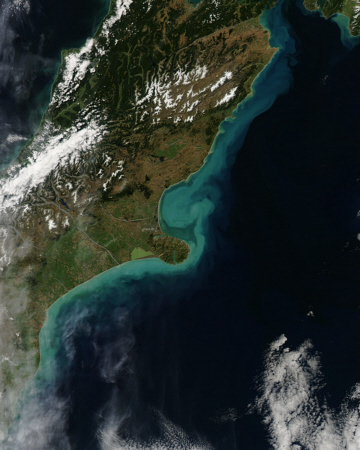
The waters near Christchurch, New Zealand glowed bright aquamarine on 2014 March 6, when the Moderate Resolution Imaging Spectroradiometer (MODIS) aboard NASA's Aqua satellite passed overhead and captured this true-color image. This bright color was most likely the result of sediment washed into the ocean from recent heavy rain and flooding. Aqua was launched aboard a Delta II rocket from Vandenberg AFB in 2002. Image courtesy Jeff Schmaltz, MODIS Land Rapid Response Team, NASA GSFC
(MAR 11) EL SEGUNDO Calif., March 11, 2014 -- Boeing's [NYSE: BA] first of four satellites for Inmarsat's Global Xpress network, has passed all of its on-orbit testing and has now been handed over to Inmarsat.
The high-speed mobile broadband satellite, launched on Dec. 8, will support a wide range of government and commercial customer uses, including in-flight connectivity, communications for vessels at sea, streaming video and other voice and data services.
Boeing is under contract to build four Inmarsat-5 satellites, with two more scheduled for completion and launch by the close of 2014. The fourth satellite is scheduled to be delivered in 2016. The Inmarsat-5 satellites carry a secondary payload that Boeing Commercial Satellite Services will lease to potential government customers through a reseller agreement with Inmarsat.
Boeing
(MAR 4) SUITLAND, Maryland -- August marks the 52nd year of continuous service for the Air Force's longest running satellite program. More
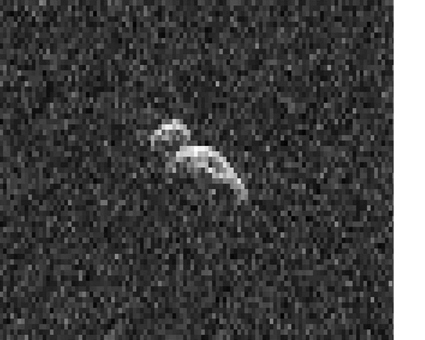
Radar reveals the shape of near-Earth asteroid 2006 DP 14 in this image from the 230-foot (70-meter) Deep Space Network antenna at Goldstone, Calif. The view is one of a collage of radar images taken on February 11 when the 1,300 foot-long (400 meter) asteroid was about 2.6 million miles (4.2 million kilometers) from Earth. The object flew by Earth the previous day. Image courtesy NASA/JPL-Caltech/GSSR
(FEB 26) MOUNTAIN VIEW, Calif. - NASA's Kepler mission announced Wednesday the discovery of 715 new planets. More
(FEB 18) SANTA BARBARA, Calif. - Stargazers might enjoy views of Jupiter's Great Red Spot at this month's public viewing at the Westmont Observatory on Friday, Feb. 21, beginning after 6:30 p.m. and lasting several hours. The free event is held every third Friday of the month in conjunction with the Santa Barbara Astronomical Unit. In case of inclement or overcast weather, please call the Telescope Viewing Hotline at (805) 565-6272 and check the Westmont website to see if the viewing has been canceled.
"Jupiter will be near the top of the sky during the early hours of the public viewing, so we should get some clear and steady views of the planet and maybe the ancient storm," says Thomas Whittemore, Westmont physics instructor.
The Great Orion Nebula may also be a highlight of the viewing. "If the weather cooperates, we may be able to see all six of the Trapezium stars in this distant stellar nursery," he says.
Last month, visitors enjoyed testing their color sense with several binary stars that Whittemore targeted. "One of my favorites was the green-reddish pair in the system, Eta Cassiopeiae," he says. "These stars are about 20 light-years away and take 500 years to orbit one another. Although they may look like they are on top of one another in the telescope, the two stars of Eta Cassiopeiae are separated by more than twice the distance Pluto is from our sun."
Westmont students and faculty use the Keck Telescope, a 24-inch reflector, to conduct astronomical research. The observatory sits between Russell Carr Field and the track and field/soccer complex. Free parking is available near the baseball field.
Westmont College

Bright layered deposits are visible in this Mars Reconnaissance Orbiter image of the Ladon Valles region of Mars released by the University of Arizona on February 12. The view was acquired by the spacecraft's HiRISE camera which is operated by the University of Arizona. Image courtesy NASA/JPL/University of Arizona
(FEB 14) Centennial, Colo. - Today, United Launch Alliance (ULA) commemorates the 25th anniversary of the proven industry workhorse rocket, the Delta II. More
(FEB 6) NASA has selected 16 small satellites from nine states to fly as auxiliary payloads aboard rockets planned to launch in 2015, 2016 and 2017. The proposed CubeSats come from universities across the country, a primary school, non-profit organizations and NASA field centers.
CubeSats are a class of research spacecraft called nanosatellites. The cube-shaped satellites measure about 4 inches on each side, have a volume of about 1 quart and weigh less than 3 pounds.
After launch, the satellites will conduct technology demonstration, educational research or science missions. The selected spacecraft are eligible for launch after final negotiations, depending on the availability of a flight opportunity. The organizations sponsoring satellites include:
-- NASA's Ames Research Center, Moffett Field, Calif. -- New Mexico Institute of Mining and Technology, Socorro, N.M. -- The Aerospace Corporation, El Segundo, Calif. -- University of California, Los Angeles -- Utah State University, Logan (2 CubeSats)
NASA
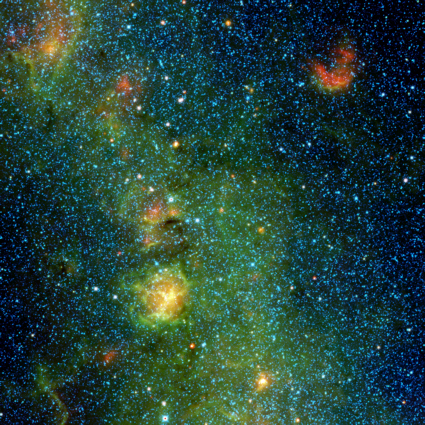
A storm of stars is brewing in the Trifid nebula, as seen in this view from NASA's Wide-field Infrared Survey Explorer, or WISE. The Trifid nebula is located 5,400 light-years away in the constellation Sagittarius. Colors in this image represent different wavelengths of infrared light detected by WISE. The WISE spacecraft was launched from Vandenberg AFB aboard a Delta II rocket in 2009 December. Image credit: NASA/JPL-Caltech/UCLA
(JAN 31) A California-built military satellite communications system may help satisfy the growing demand for communications in the arctic. More
(JAN 22) LOS ANGELES AIR FORCE BASE, El Segundo, Calif. - Since October 2012, U.S. Air Force Space Command's Space and Missile Systems Center (SMC) has been analyzing, characterizing, testing and implementing modified battery charge control rates across the GPS IIR/IIR-M fleet. This fleet of 19 satellites comprises more than half of the Global Positioning System (GPS) constellation. As of November 15, 2013, the USAF's 2nd Space Operations Squadron (2SOPS) completed the modification, which will extend the life of these satellites' operational capability.
Batteries are projected to be the primary life-limiting component when GPS IIR/IIR-M vehicles are past their design life. Analysis by SMC, The Aerospace Corporation and Lockheed Martin indicated that reducing the charge rates during solstice season would add an average of one to two years of life per space vehicle. SMC GPS directorate and 2SOPS will closely monitor the real-world results of this project to ensure they are in line with the expected gains. In total, it is anticipated that the modification will add more than 27 years of cumulative life across the GPS IIR/IIR-M fleet.
Los Angeles AFB
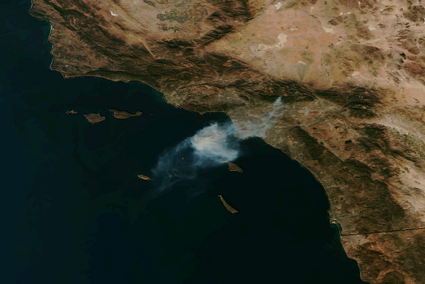
Persistent Santa Ana winds resulted in dangerous fire-weather conditions in California during the past week. The Suomi NPP satellite captured this image of the Colby Fire northeast of Los Angeles on January 16 at 20:30 UTC. Image courtesy of NASA/NOAA
(JAN 15) SANTA BARBARA, Calif. - The gas giant Jupiter will be the star performer at this month's public viewing at the Westmont Observatory on Friday, Jan. 17, beginning after 6:30 p.m. and lasting several hours. The free event is held every third Friday of the month in conjunction with the Santa Barbara Astronomical Unit. In case of inclement or overcast weather, please call the Telescope Viewing Hotline at (805) 565-6272 and check the Westmont website to see if the viewing has been canceled.
"Jupiter will split the four Galilean Moons with Callisto, Europa and Ganymede on one side of the planet and Io on the other side," says Thomas Whittemore, Westmont physics instructor. "It will be interesting to see this alignment as Callisto, the outermost of the Galilean Moons, lies very far from Jupiter."
Westmont College
(JAN 7) A NASA astronomy satellite launched from Vandenberg AFB in 2009 spots a never-before-seen asteroid following the craft's reactivation. More
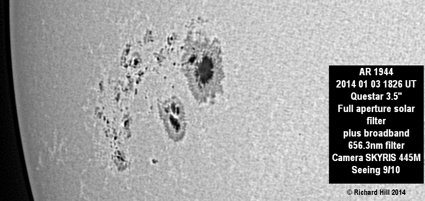
With the Sun currently at the peak of its 11-year cycle, our star's surface is populated with several spots or "active regions." Rik Hill imaged one such region, AR 1944, on January 3 from Tucson, Arizona using a 3.5-inch telescope and an electronic camera. AR 1944 unleased a coronal mass ejection (CME) in the general direction of Earth on January 4 and will probably release an M-class solar flare on January 5. Image Copyright 2014, Richard Hill. Used with permission.
(JAN 3) PASADENA, Calif. - Several sources confirm that the first discovered asteroid in 2014, designated 2014 AA, entered Earth's atmosphere late Jan. 1 (Jan. 2 Universal time) over the mid-Atlantic Ocean. More
Copyright © 2013-2015, Brian Webb. All rights reserved.